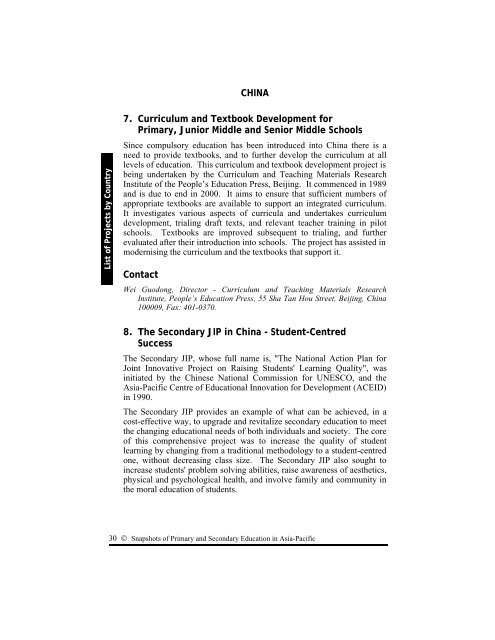Download PDF, 752KB - UNESCO Bangkok
Download PDF, 752KB - UNESCO Bangkok
Download PDF, 752KB - UNESCO Bangkok
Create successful ePaper yourself
Turn your PDF publications into a flip-book with our unique Google optimized e-Paper software.
CHINAList of Projects by Country7. Curriculum and Textbook Development forPrimary, Junior Middle and Senior Middle SchoolsSince compulsory education has been introduced into China there is aneed to provide textbooks, and to further develop the curriculum at alllevels of education. This curriculum and textbook development project isbeing undertaken by the Curriculum and Teaching Materials ResearchInstitute of the People’s Education Press, Beijing. It commenced in 1989and is due to end in 2000. It aims to ensure that sufficient numbers ofappropriate textbooks are available to support an integrated curriculum.It investigates various aspects of curricula and undertakes curriculumdevelopment, trialing draft texts, and relevant teacher training in pilotschools. Textbooks are improved subsequent to trialing, and furtherevaluated after their introduction into schools. The project has assisted inmodernising the curriculum and the textbooks that support it.ContactWei Guodong, Director - Curriculum and Teaching Materials ResearchInstitute, People’s Education Press, 55 Sha Tan Hou Street, Beijing, China100009, Fax: 401-0370.8. The Secondary JIP in China - Student-CentredSuccessThe Secondary JIP, whose full name is, "The National Action Plan forJoint Innovative Project on Raising Students' Learning Quality", wasinitiated by the Chinese National Commission for <strong>UNESCO</strong>, and theAsia-Pacific Centre of Educational Innovation for Development (ACEID)in 1990.The Secondary JIP provides an example of what can be achieved, in acost-effective way, to upgrade and revitalize secondary education to meetthe changing educational needs of both individuals and society. The coreof this comprehensive project was to increase the quality of studentlearning by changing from a traditional methodology to a student-centredone, without decreasing class size. The Secondary JIP also sought toincrease students' problem solving abilities, raise awareness of aesthetics,physical and psychological health, and involve family and community inthe moral education of students.30 © Snapshots of Primary and Secondary Education in Asia-Pacific
















